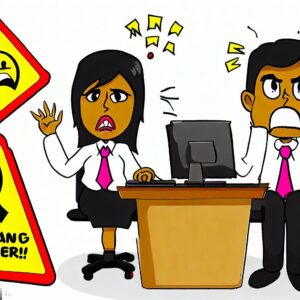In this article, we will explore into ten warning signs of an unhappy employee, and offer valuable insights on how to effectively address these issues. By proactively identifying and resolving the sources of discontentment, CEOs can foster a more positive and productive work environment, leading to enhanced employee satisfaction and bolstered organizational achievements.
For a business CEO, it is imperative to possess a deep understanding of the indications of employee dissatisfaction within your organization. The presence of unhappy employees can exert a deleterious influence on productivity, morale, and the overall success of the company.
1 – Decreased Productivity
Decreased productivity is a prominent indicator of an unhappy employee. When you witness a substantial decline in an employee’s output or a consistent failure to meet deadlines, it serves as a clear sign of dissatisfaction. This decline in productivity can be attributed to a multitude of factors, such as a lack of motivation, disengagement, or personal issues that adversely affect their work performance.
The lack of motivation can stem from various sources, including a perceived lack of recognition or reward for their efforts, limited growth opportunities, or a mismatch between their skills and job responsibilities. Feeling disconnected or disengaged from their work can also contribute to decreased productivity. When employees fail to find meaning or purpose in their tasks, they may struggle to maintain the necessary drive and enthusiasm to perform at their best.
Additionally, personal issues can significantly impact an employee’s ability to focus and perform effectively. Challenges in their personal lives, such as relationship problems, financial difficulties, or health issues, can spill over into their professional lives, leading to decreased productivity. It is essential for employers to foster a supportive work environment that recognizes the importance of work-life balance and offers resources or assistance programs to help employees navigate personal challenges.
By addressing the underlying causes of decreased productivity, such as providing opportunities for growth and recognition, fostering a sense of purpose, and offering support for personal challenges, employers can help alleviate employee dissatisfaction and improve overall productivity levels. Creating a positive work environment that values employee well-being and offers the necessary resources for success is crucial in ensuring a motivated and engaged workforce.

2 – Increased Absenteeism
Unhappy employees frequently demonstrate an elevated rate of absenteeism, which can be a cause for concern. When you observe an employee frequently calling in sick or taking unplanned time off, it serves as an indication of potential underlying dissatisfaction. Absenteeism can manifest as a reflection of various factors, including mental or physical health issues, work-related stress, or a lack of job satisfaction.
Absences related to mental or physical health issues can significantly impact an employee’s ability to perform their duties effectively. Stress, anxiety, or other mental health challenges can lead to increased absenteeism as employees may need time off to address their well-being. Similarly, physical health issues, whether chronic or acute, can require employees to take time away from work to attend medical appointments or recover from illness or injury.
Work-related stress is another significant contributor to increased absenteeism. If employees feel overwhelmed, unsupported, or excessively burdened by their workload, they may resort to taking time off as a means of coping or seeking relief. Additionally, a lack of job satisfaction can lead to disengagement and a higher likelihood of absenteeism. When employees are unhappy with their work environment, their motivation to show up consistently may dwindle.
To address increased absenteeism, employers should prioritize employee well-being and create a supportive work culture. This can include implementing policies that promote work-life balance, providing resources for mental health support, and fostering open communication channels for employees to express their concerns. By addressing the root causes of absenteeism and striving to create a positive and fulfilling work environment, employers can help mitigate dissatisfaction and reduce absenteeism rates, ultimately fostering a more engaged and productive workforce.

3 – Lack of Engagement
Lack of engagement is a crucial factor that indicates employee happiness and satisfaction. When employees feel disconnected from their work or disengaged from the organization, it can have detrimental effects on productivity and increase the likelihood of turnover. Recognizing the signs of disengagement is essential, which can include a lack of enthusiasm, minimal participation in team activities, and limited contribution to discussions or decision-making processes.
When employees lack enthusiasm for their work, it can be an indication of disengagement. They may display a lack of passion or energy, and their overall motivation to excel in their tasks may diminish. This can result in subpar performance and reduced productivity levels.
Furthermore, minimal participation in team activities can suggest a lack of engagement. Employees may be less inclined to collaborate, share ideas, or contribute to group projects. This can hinder teamwork and innovation within the organization, as valuable perspectives and insights may be overlooked.
Limited contribution to discussions or decision-making processes is another sign of disengagement. When employees feel disconnected, they may refrain from actively participating in meetings or offering their opinions. This lack of involvement can lead to missed opportunities for valuable input and hinder the organization’s ability to make well-informed decisions.
To address the issue of disengagement, organizations should focus on fostering a positive work environment that encourages employee involvement and provides opportunities for growth and development. This can include implementing initiatives such as regular feedback and recognition, promoting open communication channels, and offering training and development programs. By actively involving employees in decision-making processes and valuing their contributions, organizations can enhance engagement, boost productivity, and create a more fulfilling work experience for their employees.

4 – Negative Attitude
Unhappy employees frequently demonstrate a negative attitude towards their work, colleagues, and the organization as a whole. This negative demeanor can manifest in various detrimental ways, including constant complaining, engaging in gossip, or displaying a lack of enthusiasm. It is important to recognize that a negative attitude can be contagious and have a significant impact on the overall morale and productivity of the entire team.
When employees harbor a negative attitude, it can create a toxic work environment. Constant complaining and expressing dissatisfaction not only affect the individual’s own motivation and performance but can also spread negativity to their coworkers. This can lead to a decline in teamwork, collaboration, and overall employee engagement.
Gossiping is another common manifestation of a negative attitude. Engaging in gossip can erode trust among team members and create a hostile work environment. It can foster a culture of negativity, hinder effective communication, and damage relationships within the organization.
Furthermore, a lack of enthusiasm is often a clear indicator of a negative attitude. When employees exhibit a lack of passion or interest in their work, it can result in decreased productivity and subpar performance. This lack of engagement can also impact the quality of customer service and the overall reputation of the organization.
To address a negative attitude, organizations should prioritize promoting a positive work culture. This can be achieved by fostering open communication, encouraging constructive feedback, and providing opportunities for professional growth and development. Additionally, recognizing and rewarding positive behavior can help shift the focus towards a more optimistic and motivated workforce.
By addressing and mitigating negative attitudes, organizations can create a more harmonious work environment, boost employee morale, and enhance overall productivity and success.

5 – Increased Conflict
A surge in conflicts or tensions within the workplace often serves as a telltale sign of employee dissatisfaction. When employees are unhappy, they may find themselves embroiled in frequent arguments, disagreements, or conflicts with their colleagues or supervisors. These conflicts can have a detrimental impact on teamwork, collaboration, and the overall work environment, leading to a toxic atmosphere that hampers productivity and employee well-being.
Conflicts among employees can arise due to a variety of reasons, including differences in work styles, conflicting goals or priorities, or a lack of effective communication. When left unaddressed, these conflicts can escalate and create a hostile environment where individuals feel unsupported and unheard.
Moreover, increased conflict can significantly impede teamwork and collaboration. When employees are at odds with one another, it becomes challenging to foster a sense of unity and cooperation. This can result in decreased productivity, missed deadlines, and a decline in the quality of work produced.
To address increased conflict, organizations should prioritize conflict resolution and foster a culture of open communication and understanding. Providing employees with conflict resolution training and resources can equip them with the skills needed to navigate disagreements constructively. Additionally, encouraging regular team-building activities and promoting a supportive work environment can help mitigate conflicts and promote positive relationships among employees.
By proactively addressing conflicts and fostering a collaborative work environment, organizations can create a more harmonious workplace where employees feel valued, respected, and motivated to contribute their best. This, in turn, can lead to improved productivity, enhanced employee satisfaction, and overall organizational success.

6 – Lack of Initiative
When employees experience feelings of unhappiness or a lack of appreciation, their motivation to take initiative or exceed their job responsibilities can diminish. This lack of initiative can have detrimental effects, leading to missed opportunities for growth and stifling innovation within the organization. Therefore, it is crucial to foster a positive work environment that encourages and recognizes employees’ efforts.
A lack of initiative can stem from various factors, such as a perceived lack of support, limited career advancement opportunities, or a disconnection between individual contributions and organizational goals. When employees feel undervalued or unacknowledged, they may become complacent and limit their efforts to the bare minimum required. This not only hampers individual growth but also impedes the organization’s ability to adapt, improve, and innovate.
To address this issue, organizations should prioritize creating a work culture that values and rewards initiative. Encouraging employees to take ownership of their work, providing autonomy, and recognizing their contributions can significantly boost motivation and inspire a proactive mindset. Additionally, fostering an environment that promotes continuous learning and professional development can empower employees to seek out new challenges and embrace opportunities for growth.
Recognizing and appreciating employees’ efforts is equally important. Regularly acknowledging their achievements, providing constructive feedback, and offering opportunities for advancement can instill a sense of purpose and drive. This recognition can serve as a powerful motivator, encouraging employees to take initiative and contribute their best to the organization’s success.
By nurturing a positive work environment that values initiative and recognizes employees’ contributions, organizations can unlock their full potential, drive innovation, and foster a culture of continuous improvement. This, in turn, can lead to increased employee satisfaction, higher productivity, and long-term organizational success.

7 – High Turnover Rate
A high turnover rate within an organization can serve as a glaring indicator of employee dissatisfaction and discontent. When a substantial number of employees choose to leave the company, it becomes crucial to delve deeper into the underlying causes. Unhappy employees often feel compelled to seek better opportunities elsewhere, leading to a loss of valuable talent and an uptick in recruitment and training expenses for the organization.
The implications of a high turnover rate extend beyond mere numbers. It signifies a potential breakdown in the employee-employer relationship, indicating that something is amiss within the work environment. It is essential for organizations to recognize the significance of this issue and take proactive measures to address it.
By investigating the reasons behind employee departures, organizations can gain valuable insights into the factors contributing to dissatisfaction. This understanding can aid in implementing targeted strategies to improve employee engagement, satisfaction, and retention. It may involve conducting exit interviews, evaluating employee feedback, and fostering a culture of open communication to address concerns effectively.
Moreover, organizations should focus on creating a positive work environment that values and supports employees. This can be achieved by implementing initiatives such as providing competitive compensation, offering growth opportunities, recognizing and rewarding employee achievements, and promoting a healthy work-life balance. By prioritizing employee well-being and addressing their concerns, organizations can reduce turnover rates, retain top talent, and cultivate a thriving workforce.

8 – Reduced Communication
When employees experience unhappiness or dissatisfaction, it often manifests in a withdrawal from communication channels within the organization. They may become reluctant to actively participate in meetings, offer feedback, or share their ideas. This reduced communication has detrimental effects, as it hampers collaboration and deprives the organization of the valuable insights and perspectives that employees can contribute.
Effective communication is the lifeblood of any successful organization. It fosters a sense of belonging, encourages teamwork, and promotes innovation. When employees feel disconnected or disengaged, their willingness to communicate and contribute diminishes. This can lead to missed opportunities for problem-solving, hindered decision-making processes, and a stagnation of creativity within the organization.
To address the issue of reduced communication, organizations should proactively work towards creating an environment that encourages and values open dialogue. This can be achieved by fostering a culture of psychological safety, where employees feel comfortable expressing their thoughts and opinions without fear of judgment or reprisal. Providing platforms for regular feedback, such as surveys or suggestion boxes, can also help to facilitate communication and give employees a voice.
Additionally, leaders and managers play a crucial role in setting the tone for communication within the organization. They should lead by example, actively seeking input from employees, and demonstrating a genuine interest in their ideas and concerns. By creating opportunities for collaboration, such as team-building exercises or cross-functional projects, organizations can further encourage communication and collaboration among employees.
By addressing reduced communication and promoting a culture of open dialogue, organizations can harness the collective intelligence and creativity of their workforce, leading to enhanced productivity, innovation, and overall organizational success.

9 – Decline in Quality
Unhappiness among employees can often manifest in a noticeable decline in the quality of their work. This decline can be attributed to various factors such as a lack of motivation, disengagement, or a general feeling of dissatisfaction. However, it is crucial for organizations to recognize that the consequences of reduced quality extend beyond the internal realm of the workforce.
When employees produce work of diminished quality, it directly impacts customer satisfaction. Customers rely on organizations to deliver products and services that meet or exceed their expectations. A decline in quality can lead to dissatisfaction among customers, erode their trust in the organization, and ultimately result in a loss of business. Moreover, negative customer experiences can quickly spread through word-of-mouth, damaging the organization’s reputation and hindering its ability to attract new customers.
Furthermore, reduced quality can have far-reaching implications for the overall success of the business. It can lead to increased costs due to rework, repairs, or customer compensation. It may also result in missed deadlines, delayed projects, and decreased efficiency, which can have a negative impact on the organization’s bottom line.
To address the issue of declining quality, organizations should prioritize employee satisfaction and well-being. By fostering a positive work environment, providing opportunities for growth and development, and recognizing and rewarding employees for their contributions, organizations can help cultivate a motivated and engaged workforce. Additionally, implementing quality control measures, providing training and resources, and encouraging collaboration and feedback can contribute to maintaining high standards of quality.
By investing in employee satisfaction and emphasizing the importance of quality, organizations can create a virtuous cycle where happy employees produce high-quality work, leading to increased customer satisfaction, a positive reputation, and long-term business success.

10 – Physical and Emotional Symptoms
Unhappiness in the workplace can have significant impacts on both the physical and emotional well-being of employees, leading to a range of symptoms that warrant attention. These symptoms encompass increased stress levels, persistent fatigue, heightened irritability, difficulty concentrating, and even physical ailments like headaches or stomachaches. By recognizing and understanding these signs, employers can take proactive steps to provide the necessary support and resources to address employee well-being.
The physical symptoms experienced by unhappy employees are often a result of the prolonged stress and strain they face in their work environment. The constant pressure and dissatisfaction can lead to elevated stress levels, which, in turn, contribute to fatigue and a weakened immune system. This physical exhaustion can manifest in various ways, such as persistent tiredness, headaches, or even gastrointestinal issues like stomachaches.
In addition to the physical manifestations, unhappiness at work can also take a toll on employees’ emotional well-being. Feelings of frustration, disillusionment, and discontentment can lead to irritability and difficulty managing emotions effectively. The negative impact on concentration and focus can further exacerbate work-related challenges, making it harder for employees to perform at their best.
Recognizing these physical and emotional symptoms is crucial for employers to prioritize employee well-being. By actively observing and engaging with employees, organizations can identify signs of unhappiness and take appropriate measures to address them. This may involve providing access to resources such as counseling services, implementing stress management programs, or promoting work-life balance initiatives.
Furthermore, fostering a supportive and inclusive work environment that values open communication and empathy can help alleviate the causes of unhappiness and mitigate the associated symptoms. Regular check-ins, feedback sessions, and opportunities for employees to voice their concerns can contribute to a healthier and more positive workplace culture.
By acknowledging and addressing the physical and emotional symptoms of unhappiness at work, employers can create an environment that promotes employee well-being, productivity, and overall satisfaction. Prioritizing the mental and physical health of employees not only benefits individuals but also contributes to the long-term success and resilience of the organization as a whole.

Conclusion
Recognizing the indicators of employee unhappiness is vital in cultivating a positive work environment and securing the overall prosperity of your organization. Promptly and effectively addressing these signs can significantly enhance employee satisfaction, engagement, and productivity. It is important to remember that a contented workforce serves as a fundamental catalyst for business growth and achievement.
By prioritizing employee well-being and taking proactive measures to address their concerns, you can foster a harmonious and motivated workforce that is primed for success. Investing in the happiness of your employees is an investment in the future prosperity of your organization.
Sources
- National Institutes of Health – https://www.nih.gov/
- United States Department of Labor – https://www.dol.gov/
- Harvard Business Review – https://hbr.org/
- Society for Human Resource Management – https://www.shrm.org/
- American Psychological Association – https://www.apa.org/

